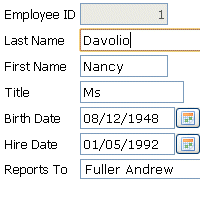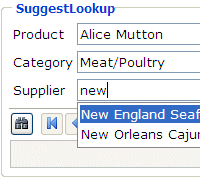
ASP.NET Ajax components
DbNetSuite is a set of lightweight integrated AJAX enabled ASP.NET components for creating web applications that interface with the database and file systems.
DbNetEdit is an ASP.NET form control that is part of DbNetSuite and can be used to maintain data from any of the supported databases.
With DbNetEdit you simply specify the names of the columns you wish to edit and let DbNetEdit take care of the rest. It will manage searching, navigation and default type validation without any coding. To create a basic maintenance application for a table requires just a few lines of code.
Individual columns can be simply listed and generated or positioned using linked EditField controls when a custom layout is required.
Lookups
When editing a value, in many cases you are required to supply a foreign key value which is linked to another table in your database. When selecting this value you typically want to be able to find this record using its descriptive text. DbNetEdit accomplishes this with the Lookup attribute which allows you to define the list of lookup values as an SQL statement. Lookups can be implemented in one of 6 different styles including the ability to search when there are large number of items to select from.
Binary data
DbNetEdit supports the editing of binary data such as images and documents either directly as a database BLOB or indirectly as a file system path. Validation can be used to control both the types and size of binary files that are uploaded to the server from the client.
HTML Editing
HTML content can be edited using the built-in HTML editor. Simply set the EditControlType property to HTML for the column and the content will be rendered in the form and edited using the HTML dialog. The dialog has both a Simple and Advanced mode for more comprehensive editing capabilities.
Auditing
The auditing capability allow changes to database records to be tracked without the need to modify any of your existing tables. Changes can be tracked at either the row or individual column level. Tracking can also operate at a summary or detail level recording either just the last or all changes. Information that can be tracked include the date/time of the change, the user and even the value that was changed.


